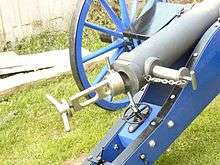8 cm Kanone C/73
| 8 cm Kanone C/73 | |
|---|---|
|
A 8 cm Kanone C/73 at the Spandau Citadel. | |
| Type | Field gun |
| Place of origin | German Empire |
| Service history | |
| In service | 1873-1922 |
| Used by | See users |
| Wars | See wars |
| Production history | |
| Designer | Krupp |
| Designed | 1873 |
| Manufacturer | Krupp |
| Produced | 1873-1891 |
| Specifications | |
| Weight | 750 kg (1,650 lb) |
| Barrel length | 1.57 m (5 ft 2 in) L/20 |
|
| |
| Shell | Separate-loading, bagged charges and projectiles |
| Shell weight |
Canister: 3.5 kg (7 lb 11 oz) HE: 4.2 kg (9 lb 4 oz) Shrapnel: 4.7 kg (10 lb 6 oz) |
| Caliber | 78.5 mm (3.09 in) |
| Breech | Horizontal sliding-block |
| Recoil | None |
| Carriage | Box trail |
| Traverse | None |
| Rate of fire | 10 rpm |
| Muzzle velocity | 400 m/s (1,300 ft/s) |
| Effective firing range | 4.8 km (3 mi) |
The 8 cm Kanone C/73 was a field gun developed after the Franco-Prussian War and used by Germany before and during World War I.
History

After the Franco-Prussian War, the German Army began to study replacements for its existing C/61 and C/64 breech loaded cannons. Although the C/61 had outclassed its French rivals during the war it's Kreiner breech an early form of double wedge breech was unpopular with gun crews. The new gun designated the C/73 would retain the same 78.5 mm (3.09 in) caliber of the C/61 and would equip cavalry artillery regiments, while a larger 88 mm (3.5 in) designated the 9 cm Kanone C/73 replaced the C/64 and was assigned to the field artillery regiments of the Army.[1]
In addition to the German Army, C/73's also armed the Ottoman Empire and a number of the Balkan states. The Balkan states either bought them from Germany or they inherited Ottoman guns after they left the region. Although largely replaced by the German Army before the First World War a combination of higher than expected losses and insufficient ammunition production led to the C/73 being brought out of reserve and issued as replacements to artillery regiments.[2]
Design
Although made of steel like its predecessor the C/73 was of built-up construction with a central rifled tube, a reinforcing hoop from the trunnions to the breech and a larger propellant chamber for higher muzzle velocities and greater range. The C/73 featured a new breech which was known as a cylindro-prismatic breech that was a predecessor of Krupp's horizontal sliding-block and the gun used separate-loading, bagged charges and projectiles.[1]
The C/73 had a box trail carriage built from bolted steel plates instead of wood. The C/73 did not have a recoil mechanism or a gun shield. For transport, the gun was attached to a limber for towing by a horse-team. The limber also had seats for crew members plus ammunition and supplies. There were also seats attached to the axle of the gun carriage for the crew.[1]
Users
Wars
Photo Gallery
| Wikimedia Commons has media related to 8 cm FK C/73. |
 A C/73 with limber.
A C/73 with limber.- A C/73 at the Tsumeb Museum, Namibia.
- The breech of an early Krupp gun.
 The breech block of the C/73.
The breech block of the C/73.